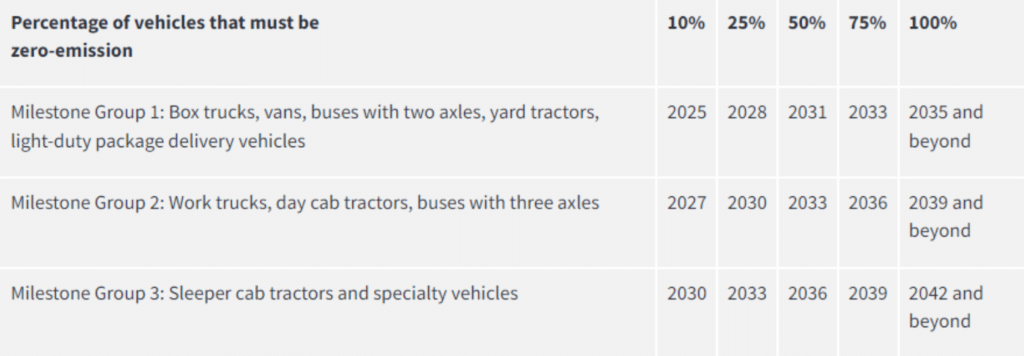In California, the landscape of electric vehicle (EV) charging is ripe with opportunity, offering numerous benefits yet sprinkled with potential pitfalls for fleets considering electrification. Two main drivers fuel the surge towards fleet electrification in California: financial incentives and regulatory mandates.
California boasts an assortment of financial incentives assisting fleets in realizing their electrification objectives:
- The California Air Resources Board (CARB) Low Carbon Fuel Standard (LCFS) issues credits per qualifying vehicle per annum, based on usage.
- The California Hybrid and Zero-Emission Truck and Bus Voucher Incentive Program (HVIP) mitigates the initial MSRPs for vehicles. While vehicle battery incentives have dwindled, HVIP still presents a viable resource and awards vehicles on a first-come, first-served basis.
- Utilities extend EV rebate programs.
- Utilities offer EV-specific time of use (TOU) rate structures. Charging during off-peak hours mitigates hefty demand surcharges and provides lower electricity charges. Notably, during these off-peak times, green power is utilized for charging if available, assisting utilities in reducing the notorious duck curve associated with renewable energy generation.
- Electric Vehicle (EV) Infrastructure Rule 29 facilitates cost reduction and expedites interconnection requests.
- Zero-Emission Commercial Vehicles (EnergIIZE) Electric Vehicle (EV) Fast Track funding extends infrastructure incentives of over $10 million to cover up to 75% of equipment and software costs for fleets.
- Incentives are also available to electrify depots in communities that have previously been underfunded and suffer from poor air quality.
However, fleets operating across multiple states confront the challenging task of navigating through the intricate web of incentives, regulatory frameworks, and rate structures. This often serves as a daunting barrier to embarking on the electrification journey.
The Imminent Advance of Clean Truck Mandates
The California Air Resources Board’s Advanced Clean Fleets (ACF) regulation promises to revolutionize fleet vehicle procurement. The ACF mandate applies to companies with at least one California-based vehicle and either $50 million in annual gross revenues or an ownership or operation of 50 or more vehicles. From January 2024, fleets must commence the transition from internal combustion engines to zero-emission vehicles to comply with the ACF rule.

A recent S&P vehicle registration data study revealed that in California alone, at least 253,000 vehicles are in Classes 2b-6, and 115,000 are in Classes 7-8. The ACF regulations will necessitate a conversion of more than 25,000 Class 2b-8 vehicles in 2025. Notably, many vehicles operate in California but are registered in other states. To comprehend the complete scope and composition of fleets that may be subjected to similar legislation elsewhere, it is insightful to examine the national level data. S&P data indicates that about 22 million vehicles are in classes 2b-8 in the US.
As setting up charging infrastructure typically requires at least 12 months, fleets must start planning for the imminent mandate. Encouragingly, we are witnessing signs of progress. San Francisco, a significant US metro area, reached a milestone with a 50% EV registration in March.
In the US, approximately 20 million vehicles, including 3 million in California, are part of return-to-depot fleets driving less than 200 miles a day on average. These fleets are excellent electrification candidates as they can optimize the use of a central location for operations and charging.
You Bring the EV, We Charge It
At Electrada, our 360 Charging-as-a-Service (CaaS) model simplifies your fleet’s transition to EVs. You provide the vehicles, and we take care of the charging. We invest in your fleet depot’s electrification and execute it with minimal operational disruption.
Our extensive experience in utility work enables us to select the most beneficial electricity rates for our fleet customers and fix that rate throughout the 360 CaaS contract. We leverage these long-term contracts to help fleets expedite the utility new service queue and navigate the EV regulations. These contracts also enable utilities to manage and optimize projected grid demand across their territories, every hour of the day.
Unlike EV charging equipment manufacturers, we are not driven by selling high-margin, oversized products. As long-term infrastructure owners, our objective is to provide the most economical electricity possible to our customers. We strive to secure as many incentives as possible, relay those reductions to our fleet customers in our 360 CaaS rates, and invest only in the charging capacity required by our customer fleets while ensuring 99% charging uptime. This collaborative approach frees fleets from hiring consultants to navigate the labyrinth of EV charging incentives, which vary significantly across the country.
From our experience and fleet customer feedback, we understand the critical importance of having charging infrastructure ready well before the arrival of vehicles. We’ve observed numerous EVs idle in depots, awaiting utility permitting or delayed infrastructure upgrades. Charging infrastructure needs to be functional on the day the vehicles are delivered, often even beforehand, to test the system and coordinate with the OEM to spec the vehicle.
Further, Electrada supports fleets by offering a charger management system to monitor usage, provide valuable analytics, and ensure optimal system utilization. This is another demonstration of how we align with fleets to meet their specific needs.
Confused about incentives, mandates, and how to begin? Reach out to our experts today. We can swiftly provide you with an impact analysis and a roadmap to help you accelerate your fleet’s EV future.



